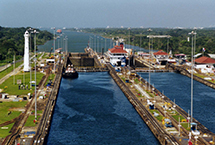 |
 |
|
| eNews • May 2015 | ||
| Promoting a Cost-Effective, Reliable and Competitive Transportation System |
||
 Panama Canal installs last lock gates
Panama Canal installs last lock gates
The Panama Canal Authority said Tuesday it has installed the last of 16 gates for the new locks being built as part of the waterway’s expansion.
According to the authority, the expansion is now 87.6 percent complete and the next milestone for the project will occur when the lock chambers are flooded.
The final gate, located at the south end of the canal, close to the Pacific entrance is one of the heaviest, weighing 4,232 tons, or roughly 8.5 million pounds. It measures 57.6 meters wide by 10 meters long and 33 meters high.
Canal Administrator Jorge L. Quijano said the installation “is a key milestone in the expansion program and another important step forward for the Canal.”
Manufactured in Italy, the new gates first arrived in Panama in four staggered shipments starting in August of 2013. With the installation of the final gate today in the Pacific, electro-mechanical work will begin to connect the gates with the other structures in the new locks.
Coincidentally, a new report from the bond rating agency Moody's tamped down expectations that when the canal opens next year there will be a big shift in cargo moving through the U.S. East Coast rather than West Coast ports.
The Moody’s report predicts opening of the new canal “will have a minimal impact on cargo volumes and revenues for US East Coast ports.”
"The handful of East Coast ports ready for the larger vessels will experience only a slight uptick in cargo traffic, with shipments mostly including non-time-sensitive and low-value goods," said Moody's in the report.
According to the report, West Coast ports will still have an edge over those on the East Coast because of faster transit times achieved by combining ocean services from China to the U.S. West Coast with intermodal rail to inland destinations or the East Coast.
"For example, transit from Shanghai to San Pedro Bay takes about 13 days by water, plus another eight days by rail to New York. In contrast, all-water service can take 26 days from Shanghai through Panama to New York. The time advantage of cargos moved through the West Coast to the Midwest is even more compelling, and ports on both coasts compete to handle these ‘discretionary’ cargo volumes," said Moody's.
The report also said West Coast ports have long-term contracts that contain minimum annual guarantees from carriers, which will protect the West Coast ports from large swings in cargo volumes and revenues.
However, the report also notes, “As trade grows, East Coast ports stand to benefit more from organic cargo growth as opposed to cargo shifts from the West Coast related to the canal expansion.”
The report added that “labor or operational difficulties at West Coast ports are wild cards, potentially minimizing their time advantage and shifting cargo to the East Coast.”
Moody’s did say that East Coast port cities such as Savannah, Charleston, and Norfolk “look to benefit economically as other entities pick up the costs of preparation for larger vessels. Since most local governments are not funding port expansion, even a muted uptick in cargo volume from Panama Canal activity will provide upside.”
Source: American Shipper
Soy Transportation Coalition |
|
